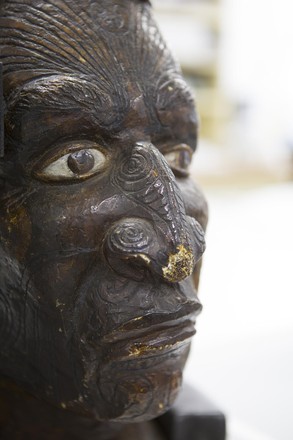Every Friday
morning, a group of us meets deep within the Library stacks to examine the
Library’s ‘realia’ collection and choose items for rehousing. Each time,
without fail, we are amazed at what we see: jewellery encrusted with colourful
gems, a small bush candle-box with the tiniest bit of wax left, or Captain
Cook’s ditty box, carved by his sailors after his death, containing a lock of
his hair.
During the year
we have rehoused 440 of the Library’s most valuable objects, many of which were
donated by Sir William Dixson as part of his large bequest to the Library in
1952. Dixson’s eclectic taste translated into an extraordinary collection of
books, manuscripts, coins, pictures, maps and relics from across the globe. His
diverse interests — with a strong focus on Australiana, but covering subjects
such as exploration, geography, natural history and Pacific history — saw one
especially interesting object reach my workbench for rehousing.
Inside an old
wooden crate, with an Angus & Robertson label and assorted packing
material, lay a carved bust of a heavily tattooed Maori male with strong
features and a mesmerising stare. Catalogued as Male Maori Head, dated c. 1880,
the bust is made from a single large piece of kauri gum resin.
Created as a by-product
of the kauri gum trade, a huge industry that thrived in New Zealand from the
1850s to the 1950s, the bust was probably carved by European gum-diggers from
resin that oozed from the kauri trees. Resin carvings were produced as tourist
pieces, mementoes and prizes in fairs.
While resin
carving was common throughout the northern parts of the north island, pieces as
large as this one are rare. Busts were often made in a mould, with the hair and
torso built up using softened resin. Details were added by painting, carving and,
because Kauri gum has a low melting point, impressing with heated metal tools.
The carvings often include authentic depictions of the tattoos of the individual
represented.
Once the gum has
hardened and set, it becomes brittle and is easily damaged. This bust has a
crack running through the back of the neck, a large section missing on the base
and small pieces broken off in other places. The weight of the Maori head made
its rehousing a challenge. A box was made to fit the bust, using archival
corrugated board reinforced with a variety of supports to aid stability while
enabling access for clients and staff.
A number of
questions about the Maori head remain unanswered. Is it a true representation of
an individual and, if so, who was he?
We welcomed additional information on this piece and thank our colleagues Colin McGregor,
Dion Peita and Logan Metcalfe from the Australian Museum, Sheri O’Neill from
the Kauri Museum and Conservator Anne Cummings for their invaluable responses
to our questions.



 Back to list
Back to list